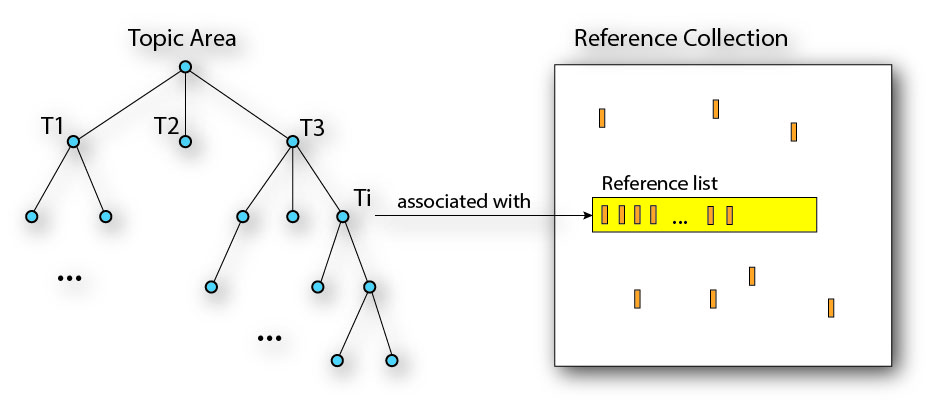Accessing Resources via Hierarchical Exploration of Topic Areas
INTRODUCTION
Resource collections
The REDEM Resource Explorer allows users to browse collections of references to resources - books and book chapters, journal, newspaper and magazine articles, opinion essays, general media and data sources - associated with topics central to REDEM. Each reference collection is associated with a Topic Area which is organised as a hierarchical structure of topics and sub-topics. The topics are in turn associated with lists of references from the reference collection. By browsing the Topic Area structure, users gain access to the reference lists associated with the topics.

REDEM Topic Areas
The REDEM project has developed topic hierarchies and reference collections to resources for 6 Topic Areas central to the project scope:
- Ethics of voting
- Political parties, secondary associations and alienation
- Direct democracy and populism
- Media and new technologies
- Inequality and marginalisation
- International politics, migration and ethnicity
The ExploRes Resource Explorer
The reference collections were initially created as static documents. The on-line resource browsing capability ExploRes has been subsequently developed by Pragma Communication to enable their rapid and effortless exploration. The ExploRes functionality has been motivated by several factors:
- EASY AND MEANINGFUL ACCESS: Topic Areas and their hierarchies are easy to understand and explore. The consultation and interpretation of resources has provided a semantic bridge between topics and resources. Topic hierarchies are thus key enablers for reaching and discovering resources in a meaningful way.
- NO DEEP DOMAIN EXPERTISE REQUIRED: The browsing of the collections using hierarchical topic structures allows users who do not have a deep familiarity with an area to easily explore it and access relevant resources.
- MAGNIFYING GLASS APPROACH: Since the topic/sub-topic hierarchies can be sizeable, the ExploRes browser operates in a lens fashion, by 'magnifying' the part of the topic tree being explored. As the user moves or jumps through the topic hierarchy, the relevant vicinity of the selected topic is dynamically expanded.
- LEARNING THROUGH EXPLORING: The structure-guided traversal of the topic tree allows the user to acquire a rapid image not only of the resource landscape, but also of the topics being visited.
How to explore
Watch the video for a 3 minute tutorial about exploring the Reference Collection.
Feel free to pause, resume or replay as needed. You can also maximise the player window for a better resolution.
Disclaimer
The resource collections are by no means complete. Some sections have just been initiated (e.g., the Party Disenchantment section in the Direct Democracy and Populism collection). The collections and sections developed during the REDEM project have concentrated on the resource areas which were central to the project. The project funding allocated to this task has also limited the coverage of the chosen resource areas. Despite this incompleteness, we hope that the level of coverage reached so far will be nevertheless of use to researchers and students and will be a compelling argument to encourage further contributions from the user community.
Credits
The Topic Areas and the reference collections, as they were developed duting the REDEM project, are the joint effort of (in alphabetical order)
- Andreas Brøgger Albertsen (University of Aarhus)
- Chiara Destri (Sciences Po Paris)
- Corrado Fumagalli (University of Genoa)
- Marcus Häggrot (Goethe University, Frankfurt a.M.)
- Attila Mràz (Sciences Po Paris)
- Elise Rouméas (Sciences Po Paris)
How to contribute
We would like to keep this resource up-to-date for the benefit of all those who find it useful. We can do so only with your help. Therefore, we would be grateful for any feedback you might have, as well as for any resource additions you would like to suggest to the database. This page tells you how. Thank you!